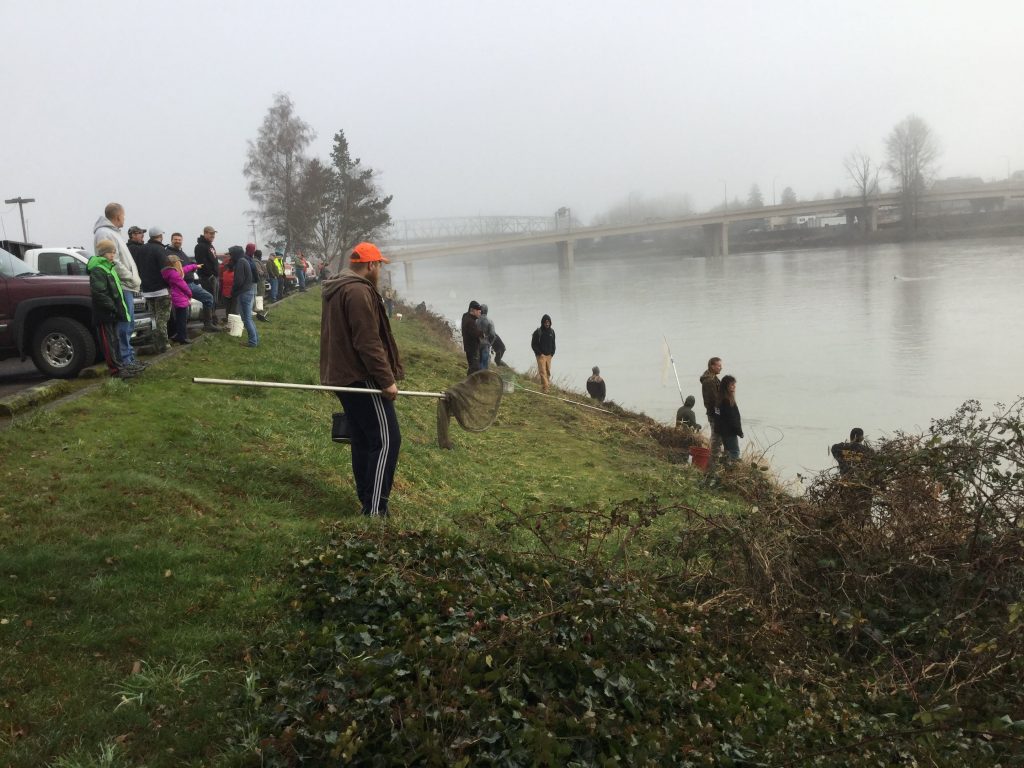
Testing Out WDFW’s New Smelt Management Plan
They’ve done it again.
WDFW has set yet another Cowlitz smelt dip on a weekday rather than the weekend.
What? The? Hell?

Is “Saturday” or “Sunday” even in the agency’s vocabulary?!?
Since 2020, they’ve held openers on, let’s see here, a Friday, a Wednesday, a Tuesday and now a Thursday.
I mean, when’s Monday gonna get some love, guys?!?
More seriously, when is the common working stiff who puts in a 40-plus-hour workweek gonna get a chance to dip some eulachon for the table and/or smokehouse and/or sturgeon bait?
There actually was a recent Saturday opener, in early March 2022, when dippers netted 169,543 pounds worth.
But back in the day, Saturdays were the day to dip smelt in the Cowlitz – especially between 1999, after WDFW began limiting dippers to specific days of the week early in the year, and 2010.
2010 was also when years of declining runs finally caught up to and saw the Columbia stock listed as threatened under the federal Endangered Species Act.
That’s a pretty serious designation; it means there’s a chance the population could become endangered, and it’s time to manage things differently and more carefully.
There were no openers in 2011, 2012 or 2013, but as the run recovered a bit, smelt dipping on select Saturdays returned at times from 2014 through 2017.
All that relatively predictable uniformity of opportunity over the decades has created something of an expectation that is meeting the new reality of WDFW trying to hold openers and provide legislatively mandated opportunity while sticking to pretty conservative federal allowable harvest rates and all sorts of other managementese that naturally most people don’t pay a lick of attention to, and I don’t blame them one bit.

But the upshot is, bring 10,000, 15,000 people and their long-handled dipnets down to a river along a major interstate corridor when the fish are in – not to mention a scofflaw or two in the mix “stuffing all the compartments of their truck” with smelt – and you can put a serious dent in that harvest rate, and fast.
“In the past, NOAA limited us to a 1 percent harvest rate, which we have exceeded with just the one-day recreational harvest, so we want to be very cautious when we approach how we set this fishery,” states Laura Heironimus, WDFW’s sturgeon, smelt, and lamprey unit lead.
Effectively, following closures in 2018 and 2019, openers have been primarily moved to weekdays to control harvest better.
Under WDFW and ODFW’s updated smelt management plan and based on preseason indicators, this year’s smelt run is being initially managed for a 2 percent harvest rate, the most conservative setting to hold any sort of recreational opportunity.
“This is the first year we are using the new management plan and we want to make sure we don’t overshoot our sustainable harvest target, especially because this is an ESA-listed species,” Heironimus says.
That plan also includes in-season harvest upgrade triggers, and it’s beginning to look like there may/might/possibly/maybe/potentially/could be a little more opportunity here in 2024, thanks to some good news from the latest nontribal commercial test fishery results.
“With the additional landings data that came out today, we are likely moving to a 5 percent harvest rate and will have some additional flexibility in the fishery,” Heironimus says. “We’ll evaluate harvest Friday, per our management plan guidance, and hopefully we’ll have plenty of room available to recommend another day of fishing.”
That test fishery is used to gauge the run and help determine sport openers, as well as collect biological data on the smelt. Between that and the inseason triggers, this plan could really help out when runs are coming in good.
A 5 percent harvest rate is the second highest available to managers. The highest is 10 percent, for when a run is forecast to be larger than 20.5 million pounds. This year’s return is “expected to be similar to or slightly lower in magnitude than the 2023 return of 17 million pounds.”

As WDFW continues to play it cautious with the stock, it also makes sense to announce a season as soon after conditions look prime as possible for these peripatetic piscines.
“A fishery set sooner means it’s more likely that we’ll still have smelt in the river to dip!” notes Heironimus.
Dippers will remember the disastrous February 26, 2020 opener. That one was announced a whopping six long days earlier, shortly after a previous opener had folks wanting more. But by the time the Cowlitz opened, there weren’t actually very many smelt to be netted in the river.
These are fish, after all, they have minds of their own, you can’t depend on them to be there like you can the gal at the end of the Costco aisle hawking cheesy shrimp puff shreds or whatever so you don’t have eat lunch before making the trip.
But if you do risk a run to Kelso and Longview, for the record, the daily limit for smelt is 10 pounds, or about a quarter of a 5-gallon bucket, according to WDFW. Dipping is open from 8 a.m. to 1 p.m., and all dippers must have their own container, and for the time being, no license is required. A bill in Olympia that would require a license to dip for smelt (a regular fishing license would cover that) passed the state House in January on a 56-39 vote and it is now before a Senate committee, though no hearing has been scheduled.
So, what does WDFW have to see to consider a Saturday opener if things continue to pan out?
“There are no set criteria in our management plan for offering a weekday vs weekend,” states Heironimus. “It’s just a matter of staff doing our best to balance the influx of effort and overall harvest to stay within our allowable harvest rate.”
Outside of with runs of 20.5 million or more, guidance from the smelt plan recommends not setting back-to-back opening days, as well as only allowing dipping in daytime so as “to maintain orderly fisheries and to stay within the target harvest rate.”
Stay tuned.
Correction, 3:39 p.m., Wednesday, February 14, 2024: The poundage for the Saturday, March 2, 2022, smelt dip was incorrectly reported as 91,250 pounds. That actually was 2021’s harvest figure. The 2022 haul was 169,543 pounds. The editor has been sacked.
*Editor’s note: Hat tip to the Portland Corps’ social media-gineer guy for being the first I saw to use this Super Bowl meme concept, I’m totally stealing it under fair-use auspices, and of course my deepest apologies to the original photogs for dragging their great work into the morass that is PNW fish management.
